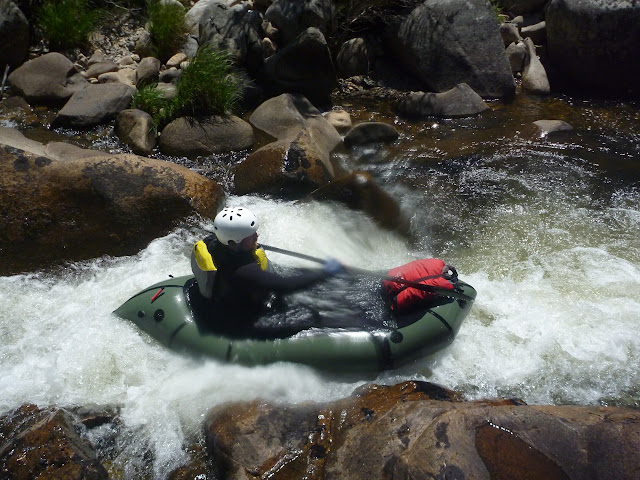One of the keener local packrafters, Steve, organised a group paddle down the gorge section via the Packrafting forums. It ended up being just the two of us who turned up. Perhaps the others had been scared off by the description in the Canoeing Guide to NSW, which contains statements like 'in high water the gorge would be continuous grade 4, 5 or even 6 rapids due to the extremely high gradient'!
Prior to setting off we patched up the damage I'd done to my packraft the previous day (see Cave Creek Packrafting for details). I had placed a bit of Patch'n'Go over the damaged tube and floor, but the gash was in an awkward spot so the repair was still leaking somewhat. Steve produced a roll of Tyvek tape and we plastered it over the tube, the floor, and also patched up my busted spraydeck from the Snowy. The Tyvek has amazing adhesive properties, and with a bit more thickness it would be the perfect packrafting repair material.
With the repairs out of the way we did the car shuffle. I had checked out the gauges the previous day and it was apparent that the water levels were low and contiuing to drop, so we opted to bypass the usual start point of the Kiandra bridge and instead put in at the end of the Four Mile Hill Trail. This trimmed off most of the paddling through the grassy plains, which would have been bony and slow going. We launched and started bobbing away through the grass, paddling past a couple of trout fisherman at one stage.
Soon the river swung hard to the left , marking the first rapid of the trip. It was a good little drop, and after a quick scout we both ran it.
The river loses a lot of gradient through the gorge, and the rapids are closely spaced. In places it feels more like a steep creek than a river. It's a beautiful setting.
As the river narrows through the gorge, the flow becomes more concentrated and it was not as bony as the section above or below. Still, some rapids were unrunnable due to boulders and ultra low volumes, so we had to portage a couple of times. Steve got adventurous and did a seal launch off one of the many smooth granite boulders, which became a common theme for the rest of the paddle.
When rivers like this are at such low levels all the hidden hazards become visible. Undercut rocks, sieves and hollows all convince me that this would not be a pleasant place to swim.
About halfway through the gorge the river flattens out slightly and goes around a kink. We had lunch here and expected the rest of the river would be fairly placid, but it soon steepened up again and threw up some more rapids for us to enjoy.
The rapids in the gorge are tight and technical, and would be continuous grade 3 with a bit more water. Even with our low levels a couple of the rapids were still grade 3s.
While there were no big drops, there were enough around the 2, 3 & 4 foot mark to keep us amused.
The gradient eased to grade 2, and there was even the occasional short pool to paddle across.
Eventually the river bed widened, making for some bony running. We continued on past the gauging station, annoying a few trout fisherman before emerging from the bush at the car. With a little more water this last section would be quite pleasant. The gauge reading at the Kiandra bridge was 5.11m.
We're claiming this as the first packraft descent of this section of river, and it sure won't be the last. Thanks to Steve for organising it all and being a great paddling companion. We'll be back again in higher water for a more adrenaline-fueled trip.
(This will be the last packrafting post from me for a while, as my poor battered raft is heading back to the factory for a few repairs)


















